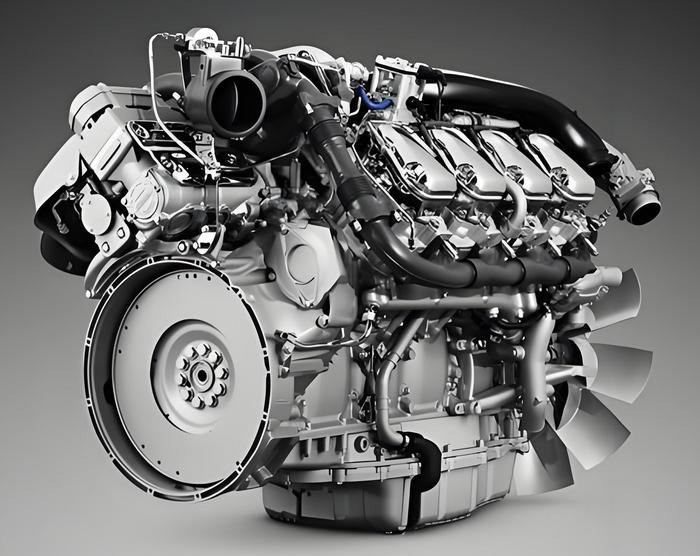
With the rapid growth of the automotive industry, engine manufacturing technology has reached a highly mature stage, leading to the emergence of numerous engine manufacturers throughout the country, proliferating like bamboo shoots after a spring rain. The engine, a complex and precise mechanical device, is assembled from tens of thousands of subcomponents, among which fasteners play a unique role as the "rice of industry," undertaking the critical task of securely connecting these subcomponents into a cohesive whole.
However, during the engine's operation, it faces extreme conditions such as high-intensity impacts, continuous severe vibrations, and extreme temperature variations. These harsh conditions often lead to potential failures in fasteners, such as torque decay and loosening, posing a serious threat to the engine's performance and safety.
Therefore, adopting scientific and reasonable tightening strategies and necessary anti-loosening measures during the manufacturing process is crucial to ensuring the long-term reliability of fasteners and the overall performance of the engine. This is not only a pursuit of technical excellence but also a solemn commitment to product quality and user safety.
- 1. Principle Analysis
1.1 Axial Clamping Force of Fasteners
Threaded fasteners connect two components through the application of torque by tightening tools, allowing them to fit tightly through thread engagement and withstand certain dynamic loads. To ensure the reliability and tightness between the connected parts, sufficient compressive force, known as the axial clamping force F, must be generated after tightening the threaded fasteners (Figure 1).
Achieving a stable axial clamping force in threaded fasteners can prevent the connected parts from shifting under working loads. Consequently, obtaining stable axial clamping force is a vital research direction for thread locking.
1.2 Analysis of Loosening Causes in Threaded Connections
During tightening, 90% of the torque is used to overcome friction, while only 10% is converted into axial clamping force. When the friction coefficient is constant, the magnitude of friction is directly proportional to the axial clamping force, which in turn affects the fastener's ability to withstand lateral loads.
Under extreme operating conditions like severe vibrations and frequent temperature changes, threaded fasteners can lose axial clamping force due to factors like varying friction coefficients, vibrations, and external varying loads. When the lateral stress acting on the fastener exceeds the friction force of the thread pair, relative movement between the fastener and the connected parts occurs, leading to a gradual decay in torque and eventually loosening or detachment. Ultimately, the key to preventing thread loosening lies in preventing relative rotation of the thread pair.
- 1. Common Anti-loosening Techniques in Automotive Engines
2.1 Tightening Methods for Threaded Fasteners
Given the significance of axial clamping force for thread locking, controlling the axial force during tightening is crucial. Common tightening methods include torque control, torque-angle control, and yield point control, each yielding different axial forces. Therefore, selecting the appropriate tightening method for different engine components is necessary.
2.1.1 Torque Control Method
This method sets the tightening tool to a specific torque value and stops when the detected dynamic torque reaches this setpoint. It is simple but prone to fluctuations in axial clamping force due to factors like operator technique and fastener manufacturing quality. Thus, it is primarily used for non-moving parts, components in mild environments, and those with low final torque requirements, such as brackets and oil pans.
2.1.2 Torque-Angle Control Method
After applying an initial torque to align the fastener and the mating part, this method rotates the fastener by a specific angle, stretching it into the plastic region. By controlling the bolt's elongation, it precisely regulates the axial clamping force. Although friction coefficient variations can affect final torque, axial clamping force remains consistent if fastener dimensions and material strength meet design requirements. This method maximizes fastener performance, accurately controls axial clamping force, and identifies defective parts, but it requires complex electric gun settings and higher costs. It is further divided into elastic region control and yield point control.
(1) Elastic Region Control: Offers moderate axial force consistency with flexible tightening angle settings, avoiding material-related fracture risks. Suitable for components requiring strict tightening reliability, like cylinder head bolts and main bearing cap bolts.
(2) Yield Point Control: Maximizes material performance and axial clamping force consistency but demands highly consistent tightening tools and fastener material properties. It is used only for the most stressed moving parts, such as connecting rod bolts.
2.1.3 Comparison of Tightening Methods
An axial force test using a factory's connecting rod bolts compared torque control, elastic region control, and yield point control. Results showed yield point control provided the most stable axial force and best anti-loosening effect but required the highest consistency and control difficulty. Torque control had the most variable axial force and poorest anti-loosening effect but was the least costly and easiest to control. Elastic region control offered stable axial force, lower material performance requirements, and the best cost





 Customer service 1
Customer service 1  Customer service 2
Customer service 2